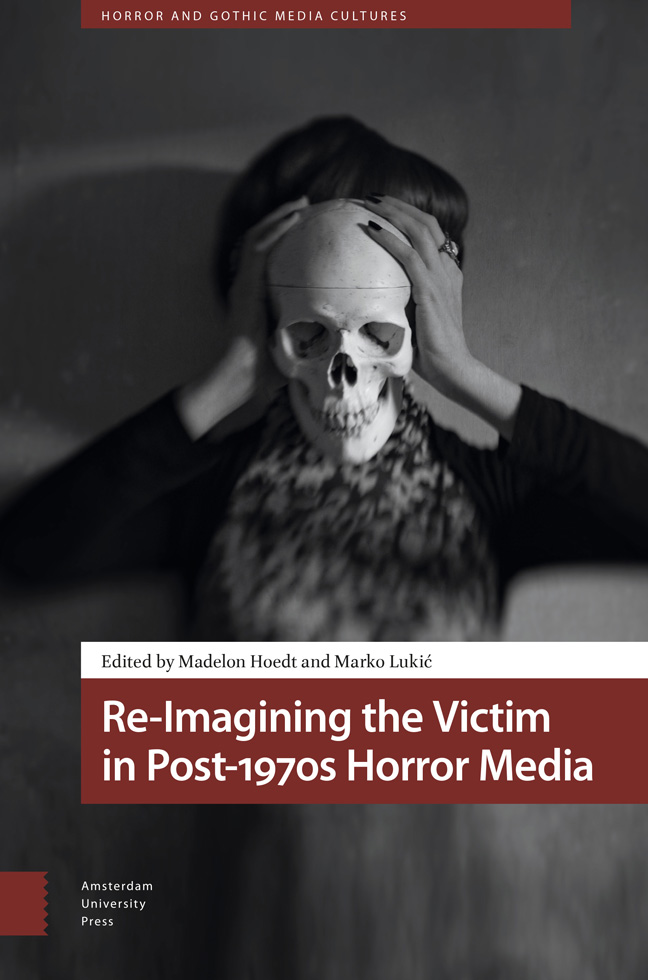Book contents
- Frontmatter
- Contents
- Introduction: Theorising the Victim
- 1 Opening the Gate: Reconfiguring the Child Victim in Stranger Things
- 2 Black Death: Black Victims in 1980s Teen Slashers
- 3 Beyond Binaries: The Position of the Transgender Victim in Horror Narratives
- 4 Through the Looking-Glass: The Gothic Victim in Jordan Peele’s Us
- 5 Postmortem Victimhood: Necrovalue in Phantasm and Dead and Buried
- 6 The Sad Killer: Perpetuating Spaces, Trauma and Violencewithin the Slasher Genre
- 7 “If this is the last thing you see… that means I died”: A Taxonomy of Camera-Operating Victims in Found Footage Horror Films
- 8 Victimhood and Rhetorical Dialectics within Clive Barker’s Faustian Fiction
- 9 Pain Index, Plain Suffering and Blood Measure: A Victimology of Driving Safety Films, 1955–1975
- 10 Biolithic Horror: Stone Victim/Victimisers in Resident Evil Village
- 11 The Potential Victim: Horror Role-Playing Games and the Cruelty of Things
- Bibliography
- Filmography
- Index
10 - Biolithic Horror: Stone Victim/Victimisers in Resident Evil Village
Published online by Cambridge University Press: 26 March 2024
- Frontmatter
- Contents
- Introduction: Theorising the Victim
- 1 Opening the Gate: Reconfiguring the Child Victim in Stranger Things
- 2 Black Death: Black Victims in 1980s Teen Slashers
- 3 Beyond Binaries: The Position of the Transgender Victim in Horror Narratives
- 4 Through the Looking-Glass: The Gothic Victim in Jordan Peele’s Us
- 5 Postmortem Victimhood: Necrovalue in Phantasm and Dead and Buried
- 6 The Sad Killer: Perpetuating Spaces, Trauma and Violencewithin the Slasher Genre
- 7 “If this is the last thing you see… that means I died”: A Taxonomy of Camera-Operating Victims in Found Footage Horror Films
- 8 Victimhood and Rhetorical Dialectics within Clive Barker’s Faustian Fiction
- 9 Pain Index, Plain Suffering and Blood Measure: A Victimology of Driving Safety Films, 1955–1975
- 10 Biolithic Horror: Stone Victim/Victimisers in Resident Evil Village
- 11 The Potential Victim: Horror Role-Playing Games and the Cruelty of Things
- Bibliography
- Filmography
- Index
Summary
Abstract
This paper explores the horror of stone and nonhuman victimhood, aiming to contribute to Ecogothic research (Keetley and Silvis; Smith and Hughes) through a videogame case study that problematises the borders of victim/victimiser, player/avatar and animate/inanimate. Resident Evil Village (Capcom, 2021) is a game of Gothic minerals: castle masonry, caves, crystals and rusted metal. I use Cohen and Callois’s work to argue that Village’s stone problematises victimhood, agency and embodiment through what I term “biolithic” entanglements and that “visual” and “inert” background assets possess an underappreciated and unsettling centrality in videogames. Surviving Village involves reckoning with the ineffable and inexhaustible complexity of materiality that frustrates player agency: while pebbles may be trodden underfoot, from stone we emerge and to stone we return.
Keywords: minerals, nonhuman, monsters, Ecogothic, lithic, game ecocriticism
Bedrock
Resident Evil Village (Capcom 2021) is a videogame founded in an accretion of Gothic materials: castle masonry, caves, ceramic dolls and rusted metal. This litany of minerals subtends its first-person horror where Eastern European– coded werewolves and vampires are all progeny of a monstrous mold, as with its bayou-based prequel Resident Evil 7: Biohazard (Capcom, 2017; McGreevy et al.), but here the player excavates the monsters’ subterranean origins born from abject loss and fights creatures that leave crystal corpses. The catalyst for the action is the petrification of protagonist Ethan’s daughter, Rose, by a family of Gothic monsters whose matriarch is trying to convert her monstrous-feminine power (Creed) to bring her child back to life, entangling multiple human/nonhuman victimhoods. As Rose’s latent power intimates, all characters here are monstrous: the player-protagonist’s body is revealed to be nothing more (or less) than a cave-mold copy of a man with the same materiality as the magnetically empowered metallurgist Heisenberg and the vampiric Lady Dimitrescu, who are gunned down to ash and crystal. In an amplification and subversion of the survival horror relationship where the player-victim “exists only by and for the monster,” our avatar and fictive daughter are repeatedly broken and recombined, cast as a mutable, monstrous mineral substance abused by the different nonhuman agencies of the narrative (Perron 130). Moreover, these monsters are themselves all victims of subterranean experiments and internecine strife, given homes beneath the rocks of this mountainous landscape.
- Type
- Chapter
- Information
- Re-Imagining the Victim in Post-1970s Horror Media , pp. 191 - 212Publisher: Amsterdam University PressPrint publication year: 2024

